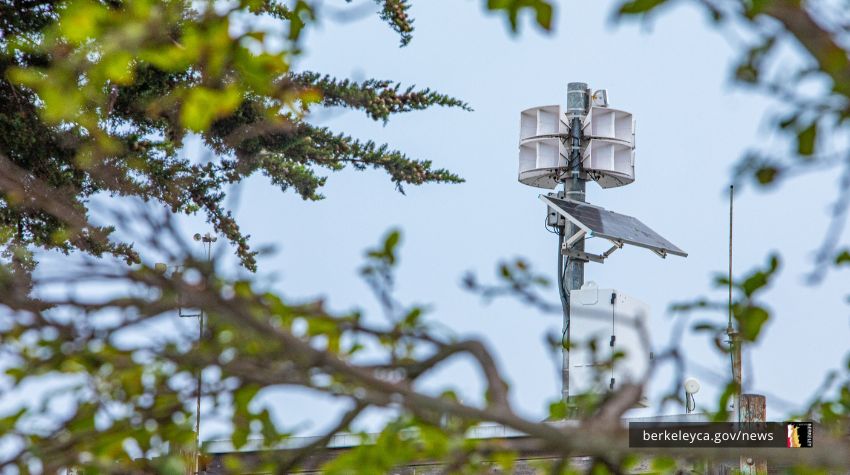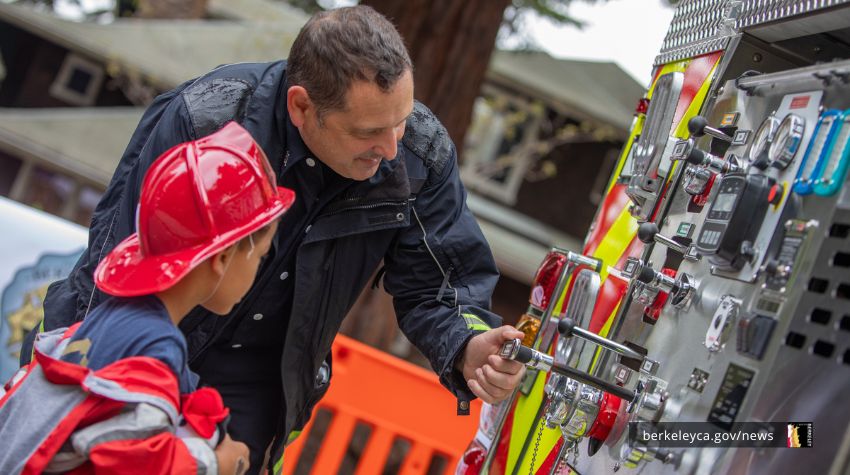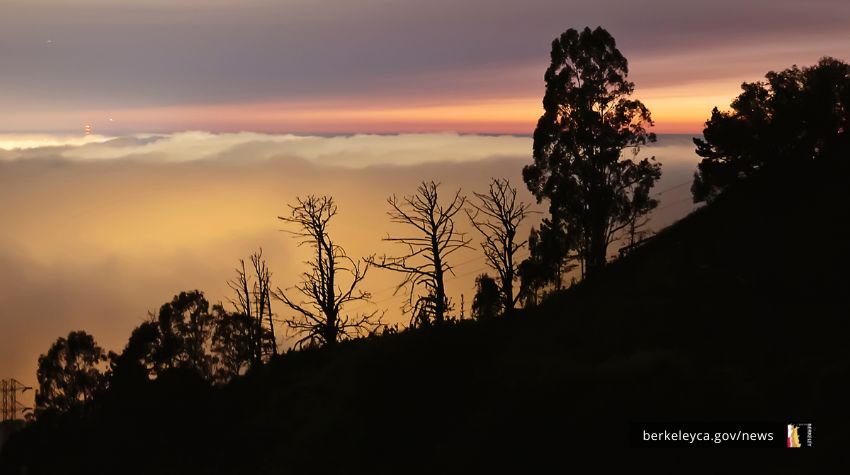Fire Weather and Evacuation
Protect yourself and your family. Be ready for fire weather and evacuation with these tools and information.
Wildfires are now more frequent, destructive, and fast-moving than ever. Berkeley residents must change how we prepare and respond.
Take control before a fire starts
Protect yourself and your family. Sign up for emergency notifications. Make a household fire weather plan. Be ready to leave the hills when the Berkeley Fire Department proclaims Extreme Fire Weather due to forecasted low humidity and high winds.
Watch our Wildfire Readiness video series
In this video series, you’ll learn about Berkeley’s growing wildfire threat, important fire weather terms to understand, and the steps you should take to be ready.
Videos include:
- Fire in our own backyard: our growing fire threat and why you should leave before a fire starts
- What you can do: four key steps to take control before a wildfire starts
- Berkeley’s fire weather: Red Flag Warnings and Extreme Fire Weather – when to leave the hills, and why
- Fire weather planning: a step-by-step guide to completing your household fire weather plan
Stay informed
When fire threatens, information may change rapidly. Use these sources for the most up-to-date information from officials:
Website
During a major emergency, information will also be available in accessible formats on the City of Berkeley website.
Emergency Map
During an emergency, review Berkeley’s Real-Time Emergency Map to find emergency information, like evacuation orders or open shelters.
Bookmark the map on your web browser so you can quickly find it in an emergency. Take note of how to navigate the search bar to find information on the locations you care about. Knowing how to use the website means you can act faster in an emergency.
AC Alert
Sign up for AC Alert, Berkeley’s main emergency alerting system, to get alerts about addresses of interest including locations you care about – such as your home, office, or a child’s school.
AC Alert can send voice alerts to phones, SMS text messages, email, and TTY/TDD messages. AC Alert is an opt-in system, so if you do not sign up, you will not receive these vital alerts. In addition, if your information changes, you must update the system in order to continue receiving alerts.
You can see the latest AC Alert messages in Alameda County at the AC Alert Notifications page.
Social Media
Follow the City of Berkeley’s X (Twitter) account. This account may offer additional emergency information.
-
X (Twitter): @CityofBerkeley, @BerkeleyPolice
-
Threads: @CityofBerkeley
-
Instagram: @cityofberkeley, @BerkeleyFireDept
-
Nextdoor: City of Berkeley, Berkeley Fire Department, Berkeley Police Department
Also, if you have not signed up for AC Alerts, you can still monitor Alameda County Office of Emergency Service's X (Twitter) account for AC Alert messages throughout Alameda County.
Radio - 1610 AM
1610 AM is an FCC-licensed radio station run by the City of Berkeley. The station plays recorded messages. In a disaster, the City may use 1610 AM to disseminate emergency information and instructions to the Berkeley community.
The 1610 AM broadcast is audible in most, but not all, areas of Berkeley. The City has authorized KPFA radio to rebroadcast or simulcast the 1610 AM signal on KPFB - 89.3 FM. In an emergency, KPFA staff will determine whether or not to rebroadcast or simulcast the 1610 AM signal.
Understand fire weather and warnings
Wildfire threat is closely tied to weather conditions. Officials will use the terms below to communicate current risk levels. Learn what they mean so you can take appropriate action to protect yourself.
For an in-depth explanation of these terms, watch our video about fire weather.
Red Flag Warning
The National Weather Service declares a “Red Flag Warning” when low humidity and high winds combine for elevated fire risk.
During a Red Flag Warning, keep your phone on and with you at all times, avoid any activities that could cause a spark, and be prepared to rapidly evacuate if necessary.
Extreme Fire Weather
The Berkeley Fire Department declares “Extreme Fire Weather”—a Berkeley-specific designation—when forecasted wind speeds and humidity levels during a Red Flag Warning would produce especially risky conditions in Berkeley.
Fires that spread under Extreme Fire Weather conditions can quickly become catastrophic.
The Berkeley Fire Department recommends that residents make plans to leave the hills during periods of Extreme Fire Weather.
Extreme Fire Weather is far more rare than Red Flag Warnings. In 2020, Berkeley had 25 days of Red Flag Warnings and only 2 days of Extreme Fire Weather. Yet this narrow range of weather conditions is when the most destructive fires happen.
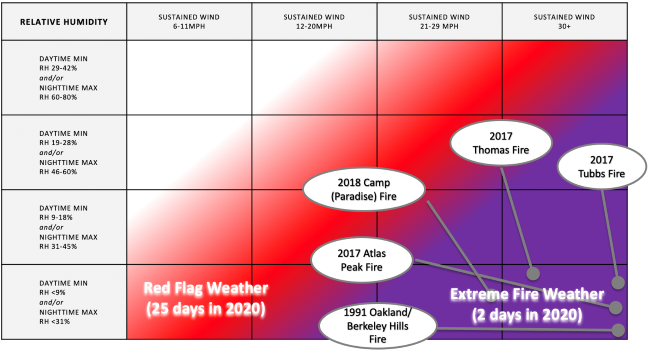
The 1991 Oakland/Berkeley Hills fire, as well as most of California’s recent firestorms, ignited when conditions were within Berkeley’s “Extreme Fire Weather” thresholds.
Fire evacuation
In the event of a fire, we will send evacuation notifications over AC Alert. You will get different types of alerts based on the current threat level in your evacuation zone:
- Evacuation Warning: Sent to notify you of a known, active fire that potentially threatens your area.
If you get an evacuation warning, get ready to evacuate on immediate notice. If you have children, pets, mobility issues, or any other factors that would make it hard to get out quickly on foot, you should leave when you get an evacuation warning.
Note that in a fast-moving fire, there may not be time to issue a warning before an evacuation is ordered. - Evacuation Order: Sent when there is an immediate life safety threat in your area, such as an active wildfire.
These are lawful orders, and everyone must leave immediately when an Evacuation Order is issued.
Make a fire weather plan
Fires are unpredictable and conditions can change rapidly. Make a plan with your household ahead of time for what you will do during fire weather.
Download our step-by-step guide to creating your household fire weather plan. Your plan will:
Identify your trigger for leaving the hills
Will you wait to evacuate after fire starts, or will you leave during periods of heightened threat?
If you live in Fire Zone 2 or 3 (the Berkeley hills),the Berkeley Fire Department recommends that you leave during Extreme Fire Weather, before a fire starts.
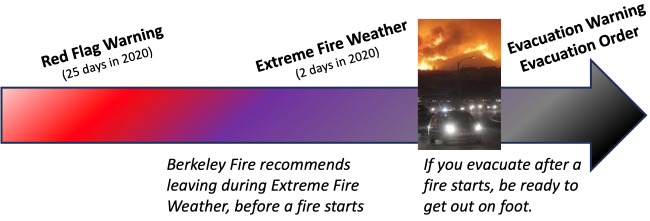
Leaving early gives you the most control over how you will get down the hill and what you can bring. If you leave after a fire starts, you may not be able to get out with your car, so you must be prepared to evacuate on foot.
Decide where you will go
Whether you plan to leave early or after a fire starts, think ahead of time about where you’ll stay. Talk to friends and family who you might be able to stay with, or consider putting aside money to stay in a hotel. Some local hotels offer special rates to residents during fire season.
In an evacuation, we will set up mass care sites for those who have no place to go, but these will take time to set up and will rarely be your most comfortable option.
Identify evacuation routes
Choose at least two routes by foot and two routes by car. For driving routes, focus on main roads that connect with major streets and highways. Bigger roads will have more space during an evacuation. This Emergency Access and Evacuation Network map identifies roads with capacity for more cars.
If available, foot paths generally offer more direct walking routes downhill than City streets. Berkeley Path Wanderers sells a high quality, durable map that includes footpaths. Consider purchasing a copy for your go-bag and highlighting potential routes in advance.
For additional guidance, watch our video guide to making a household fire weather plan.
Be ready to evacuate
Leaving the hills during Extreme Fire Weather provides significant protection to you and your family. But it does not eliminate risk entirely. Fires can ignite and spread under normal conditions.
Berkeley residents, and hills residents especially, should always be ready to evacuate rapidly if needed:
- Have a go-bag
In an evacuation, you may have only moments to leave. Everyone in your home needs a “go-bag” with the items you need to safely evacuate, including a flashlight, map marked with evacuation routes, a whistle to signal for help, cash, and copies of important documents.
Make sure your go-bag is light enough to carry if you have to leave your vehicle and evacuate on foot. Use our wildfire evacuation checklist as a guide to pack your go-bag. - Practice evacuating with your household
Review your plan and practice your evacuation routes with your household. Carry your go-bag with you when you practice.
Regular practice ensures everyone will know what to do in an emergency, when you must act quickly. - Stay alert during fire weather
Keep your phone on and with you at all times during a Red Flag Warning. Put go-bags by the door and back into your driveway so it will be easier to get out quickly.
Review your evacuation zone and your evacuation plans with your household.
Download our evacuation checklist and keep it in a prominent place in your home.
Discover tools and resources
- Learn how to Prepare your Property for Wildfire
- Prepare your family (CalFire): Resources on preparedness targeted to the specific needs of seniors, people with disabilities, and families with young children.
- ReadyKids: Wildfires (Ready.gov)
Recursos en Español
- Información y recursos en Español (CalFire)
Related Documents
News

